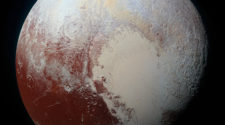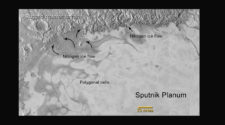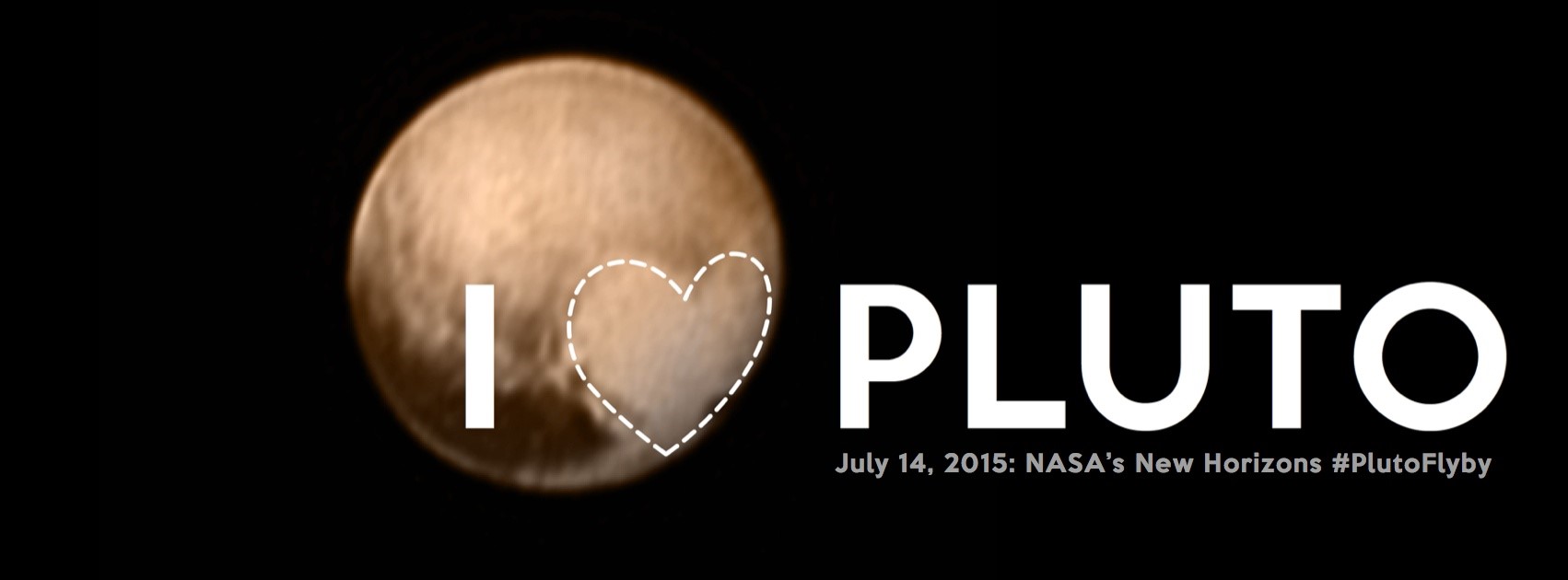
After traveling more than three billion miles during a nine-and-a-half year journey, the New Horizons spacecraft has made a successful investigative flyby of Pluto. With the achievement, the United States via NASA has become the first country to send a spacecraft to all nine of the classical planets of our solar system. Yes, we said nine, not eight planets. When New Horizons was launched on January 19, 2006, Pluto still had full planetary status. It was later demoted to a dwarf planet by a vote of 424 astronomers during the last hours of a meeting of the International Astronomical Union in Prague on August, 24, 2006. The furor of that decision continues to resonate among scientists and the public, and with the first ever closeup views of the planet now streaming back from New Horizons as it speeds through the Kuiper Belt, that debate is likely to continue.
While New Horizons was observing Pluto and its moons, the spacecraft was not transmitting data back to Earth. Due to the slow speed of New Horizon’s data transmission capabilities, it will take 16 months for all the images and data collected during the flyby to be sent back to Earth.
For more information about the Pluto mission, consider reading our earlier article, ‘New Horizons: Pluto garners the spotlight‘.
For more information about the Deep Space Network on Earth that is communicating with New Horizons, and many other spacecraft, consider reading our feature, ‘Deep Space Network: Finding the signal for 50 years’.
As new images and data are released during the next few days by NASA and the John Hopkins Applied Physic Laboratory, we’ll continue to update this page with that information.
Editor’s Note: The next New Horizons science update occurred at 2 p.m. EDT on Friday, July 24. Click here for that article.
July 21, 2015 updates:
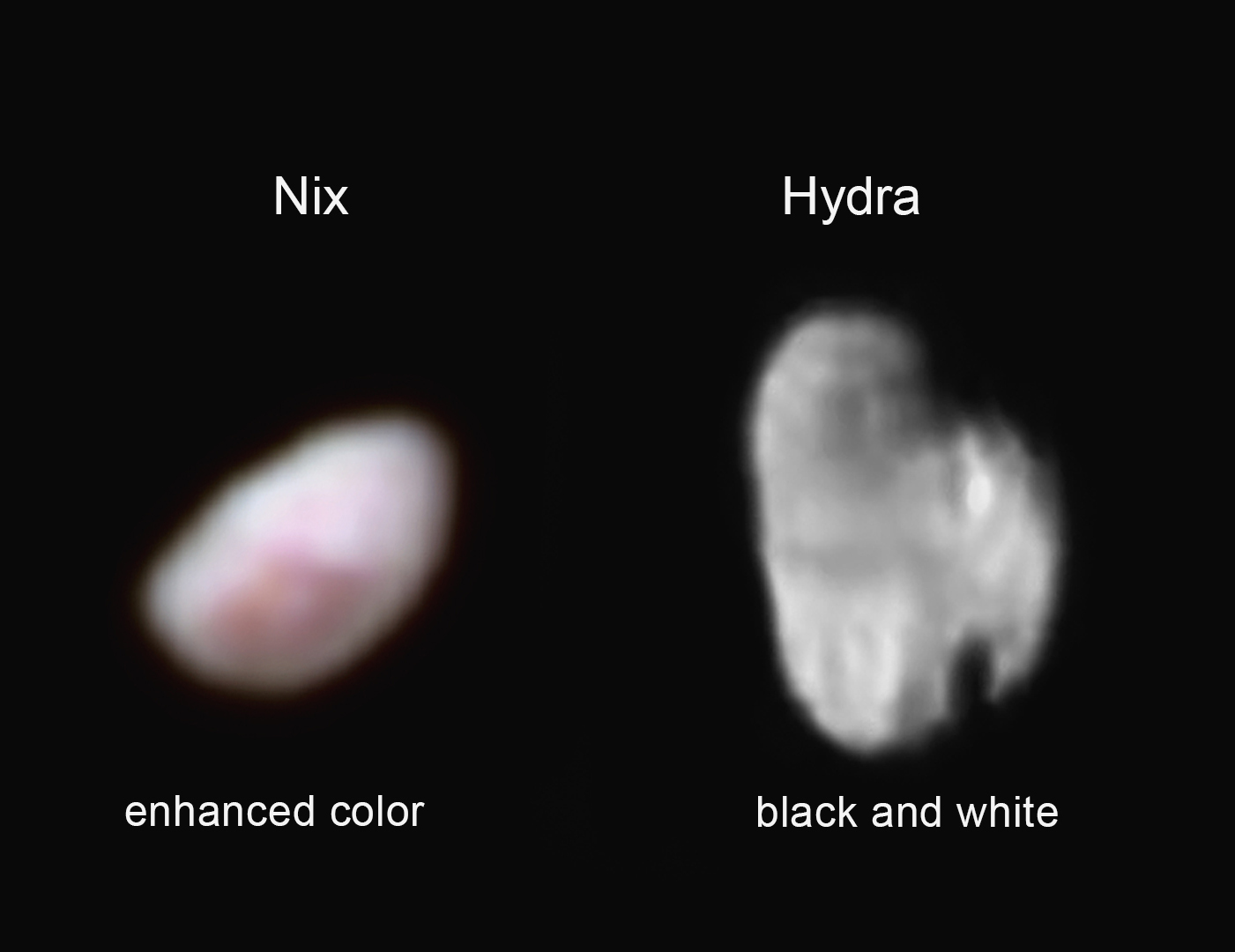
New Horizons captures images of Nix and Hydra – two of Pluto’s smaller moons
While Pluto’s largest moon, Charon, has grabbed most of the lunar spotlight, two of Pluto’s smaller and lesser-known satellites are starting to come into focus via new images from NASA’s New Horizons spacecraft.
Nix and Hydra – the second and third moons to be discovered – are approximately the same size, but their similarity ends there.
New Horizons’ first color image of Nix, in which colors have been enhanced, reveals an intriguing region on the jelly bean-shaped satellite, which is estimated to be 26 miles (42 kilometers) long and 22 miles (36 kilometers) wide.
Although the overall surface color of Nix is neutral grey in the image, the newfound region has a distinct red tint. Hints of a bull’s-eye pattern lead scientists to speculate that the reddish region is a crater.
“Additional compositional data has already been taken of Nix, but is not yet downlinked. It will tell us why this region is redder than its surroundings,” said mission scientist Carly Howett, of the Southwest Research Institute, Boulder, Colorado. She added, “This observation is so tantalizing, I’m finding it hard to be patient for more Nix data to be downlinked.”
Meanwhile, the sharpest image yet received from New Horizons of Pluto’s satellite Hydra shows that its irregular shape resembles the state of Michigan. The new image was made by the Long Range Reconnaissance Imager (LORRI) on July 14, 2015 from a distance of 143,000 miles (231,000 kilometers), and shows features as small as 0.7 miles (1.2 kilometers) across. There appear to be at least two large craters, one of which is mostly in shadow. The upper portion looks darker than the rest of Hydra, suggesting a possible difference in surface composition. From this image, mission scientists have estimated that Hydra is 34 miles (55 kilometers) long and 25 miles (40 kilometers) wide.
“Before last week, Hydra was just a faint point of light, so it’s a surreal experience to see it become an actual place, as we see its shape and spot recognizable features on its surface for the first time,” said mission science collaborator Ted Stryk, of Roane State Community College in Tennessee.
Images of Pluto’s most recently discovered moons, Styx and Kerberos, are expected to be transmitted to Earth no later than mid-October.
Nix and Hydra were both discovered in 2005 using Hubble Space Telescope data by a research team led by New Horizons project scientist Hal Weaver, Johns Hopkins University Applied Physics Laboratory, Laurel, Maryland. New Horizons’ findings on the surface characteristics and other properties of Nix and Hydra will help scientists understand the origins and subsequent history of Pluto and its moons.
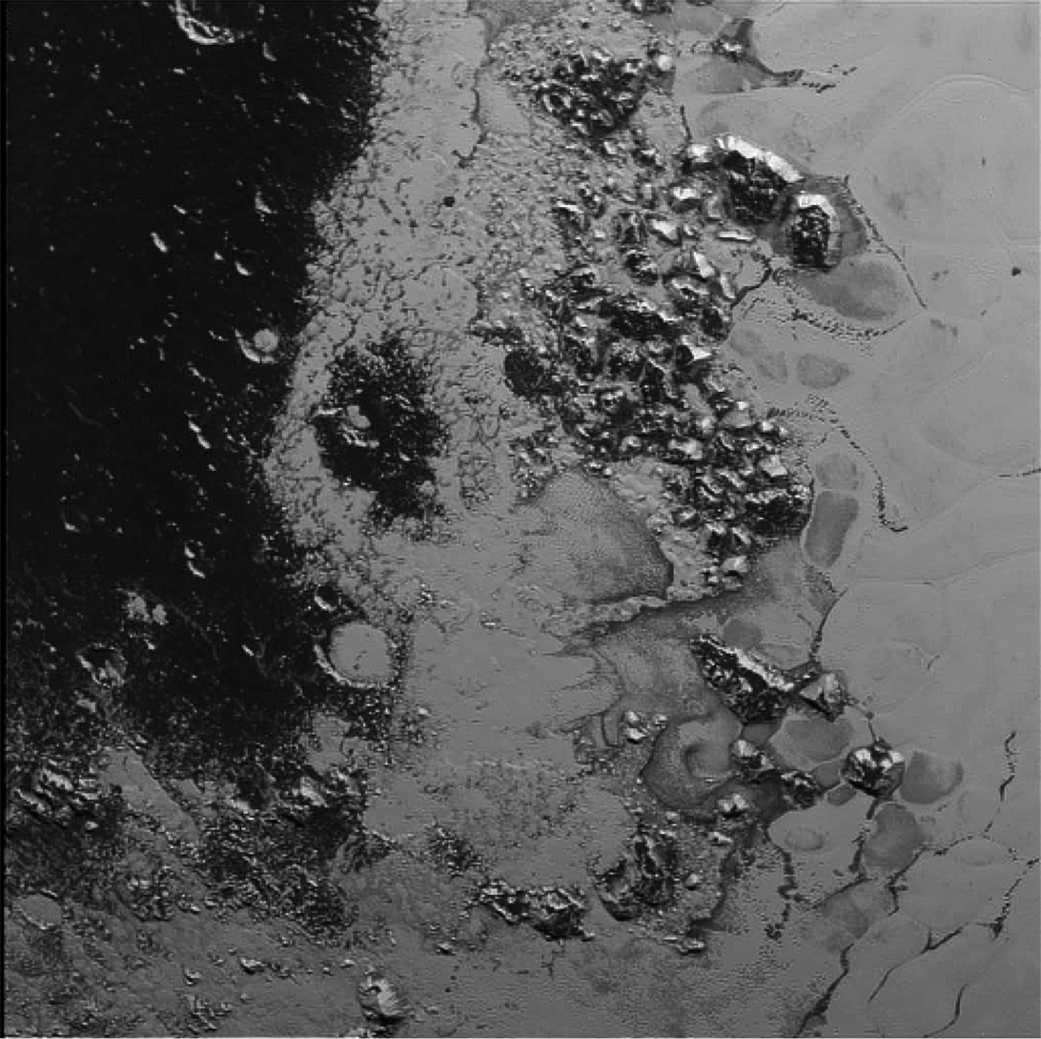
Second mountain range discovered within Pluto’s Heart
Pluto’s icy mountains have company. NASA’s New Horizons mission has discovered a new, apparently less lofty mountain range on the lower-left edge of Pluto’s best known feature, the bright, heart-shaped region named Tombaugh Regio (Tombaugh Region).
These newly-discovered frozen peaks are estimated to be one-half mile to one mile (1-1.5 kilometers) high, about the same height as the United States’ Appalachian Mountains. The Norgay Montes (Norgay Mountains) discovered by New Horizons on July 15 more closely approximate the height of the taller Rocky Mountains.
The new range is just west of the region within Pluto’s heart called Sputnik Planum (Sputnik Plain). The peaks lie some 68 miles (110 kilometers) northwest of Norgay Montes.
This newest image further illustrates the remarkably well-defined topography along the western edge of Tombaugh Regio.
“There is a pronounced difference in texture between the younger, frozen plains to the east and the dark, heavily-cratered terrain to the west,” said Jeff Moore, leader of the New Horizons Geology, Geophysics and Imaging Team (GGI) at NASA’s Ames Research Center in Moffett Field, California. “There’s a complex interaction going on between the bright and the dark materials that we’re still trying to understand.”
While Sputnik Planum is believed to be relatively young in geological terms – perhaps less than 100 million years old – the darker region probably dates back billions of years. Moore notes that the bright, sediment-like material appears to be filling in old craters (for example, the bright circular feature to the lower left of center).
This image was acquired by the Long Range Reconnaissance Imager (LORRI) on July 14 from a distance of 48,000 miles (77,000 kilometers) and sent back to Earth on July 20. Features as small as a half-mile (1 kilometer) across are visible. The names of features on Pluto have all been given on an informal basis by the New Horizons team.
July 17, 2015 updates:
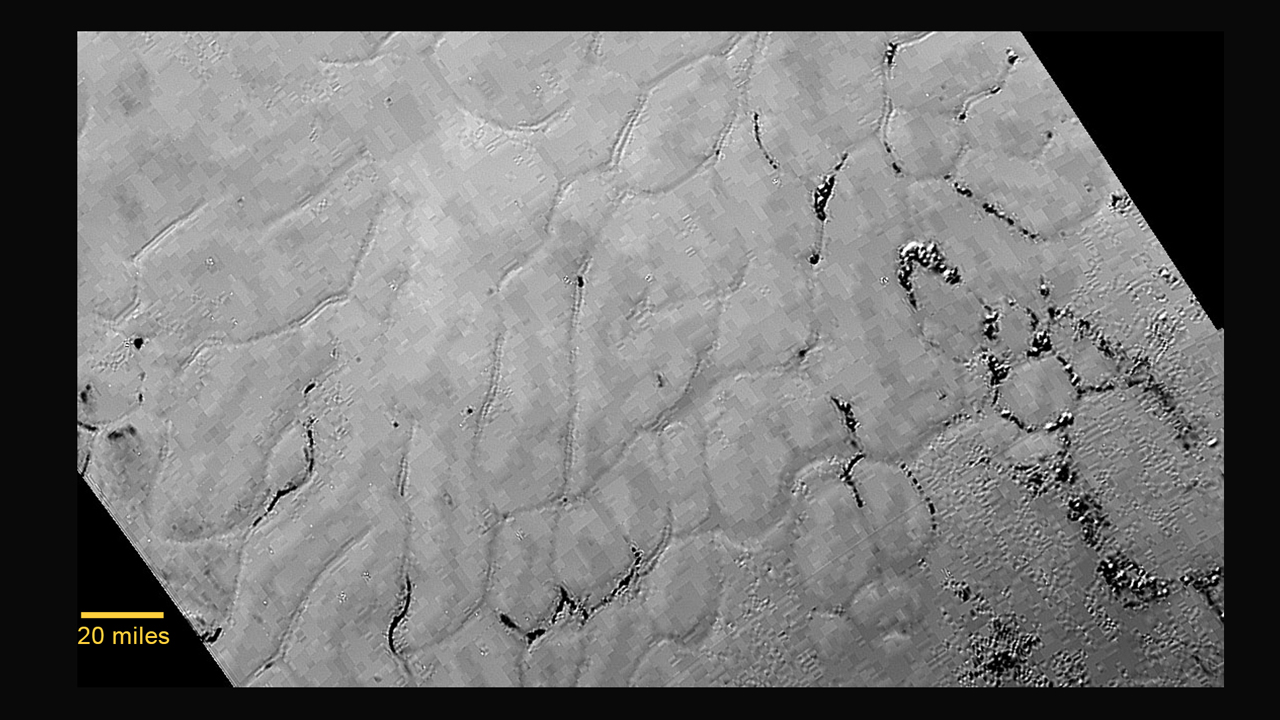
NASA’s New Horizons discovers frozen plains in the heart of Pluto’s ‘Heart’
In the latest data from NASA’s New Horizons spacecraft, a new close-up image of Pluto reveals a vast, craterless plain that appears to be no more than 100 million years old, and is possibly still being shaped by geologic processes. This frozen region is north of Pluto’s icy mountains, in the center-left of the heart feature, informally named “Tombaugh Regio” (Tombaugh Region) after Clyde Tombaugh, who discovered Pluto in 1930.
“This terrain is not easy to explain,” said Jeff Moore, leader of the New Horizons Geology, Geophysics and Imaging Team (GGI) at NASA’s Ames Research Center in Moffett Field, California. “The discovery of vast, craterless, very young plains on Pluto exceeds all pre-flyby expectations.”
This fascinating icy plains region — resembling frozen mud cracks on Earth — has been informally named “Sputnik Planum” (Sputnik Plain) after the Earth’s first artificial satellite. It has a broken surface of irregularly-shaped segments, roughly 12 miles (20 kilometers) across, bordered by what appear to be shallow troughs. Some of these troughs have darker material within them, while others are traced by clumps of hills that appear to rise above the surrounding terrain. Elsewhere, the surface appears to be etched by fields of small pits that may have formed by a process called sublimation, in which ice turns directly from solid to gas, just as dry ice does on Earth.
Scientists have two working theories as to how these segments were formed. The irregular shapes may be the result of the contraction of surface materials, similar to what happens when mud dries. Alternatively, they may be a product of convection, similar to wax rising in a lava lamp. On Pluto, convection would occur within a surface layer of frozen carbon monoxide, methane and nitrogen, driven by the scant warmth of Pluto’s interior.
Pluto’s icy plains also display dark streaks that are a few miles long. These streaks appear to be aligned in the same direction and may have been produced by winds blowing across the frozen surface.
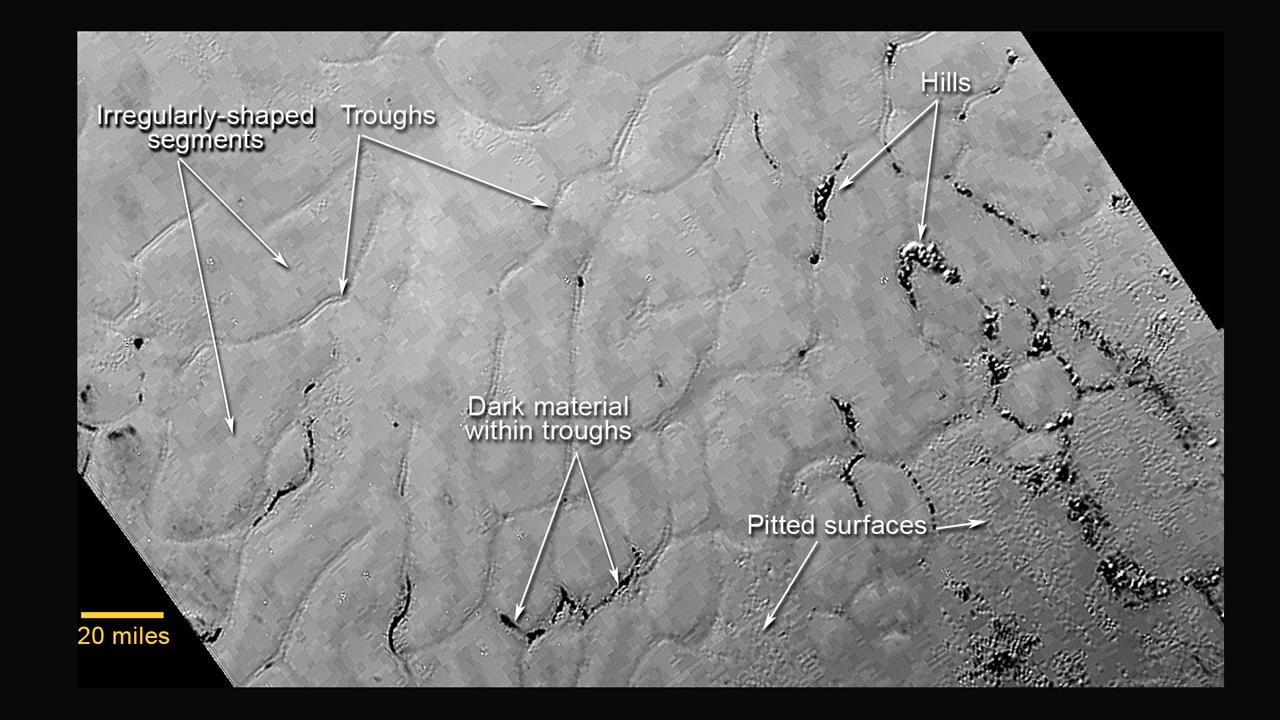
The Tuesday “heart of the heart” image was taken when New Horizons was 48,000 miles (77,000 kilometers) from Pluto, and shows features as small as one-half mile (1 kilometer) across. Mission scientists will learn more about these mysterious terrains from higher-resolution and stereo images that New Horizons will pull from its digital recorders and send back to Earth during the next year.
The New Horizons Atmospheres team observed Pluto’s atmosphere as far as 1,000 miles (1,600 kilometers) above the surface, demonstrating that Pluto’s nitrogen-rich atmosphere is quite extended. This is the first observation of Pluto’s atmosphere at altitudes higher than 170 miles above the surface (270 kilometers).
The New Horizons Particles and Plasma team has discovered a region of cold, dense ionized gas tens of thousands of miles beyond Pluto — the planet’s atmosphere being stripped away by the solar wind and lost to space.
“This is just a first tantalizing look at Pluto’s plasma environment,” said New Horizons co-investigator Fran Bagenal, University of Colorado, Boulder.
“With the flyby in the rearview mirror, a decade-long journey to Pluto is over –but, the science payoff is only beginning,” said Jim Green, director of Planetary Science at NASA Headquarters in Washington. “Data from New Horizons will continue to fuel discovery for years to come.”
Alan Stern, New Horizons principal investigator from the Southwest Research Institute (SwRI), Boulder, Colorado, added, “We’ve only scratched the surface of our Pluto exploration, but it already seems clear to me that in the initial reconnaissance of the solar system, the best was saved for last.”
Animated flyover of Pluto’s icy mountain and plains
This simulated flyover of Pluto’s Norgay Montes (Norgay Mountains) and Sputnik Planum (Sputnik Plain) was created from New Horizons closest-approach images. Norgay Montes have been informally named for Tenzing Norgay, one of the first two humans to reach the summit of Mount Everest. Sputnik Planum is informally named for Earth’s first artificial satellite. The images were acquired by the Long Range Reconnaissance Imager (LORRI) on July 14 from a distance of 48,000 miles (77,000 kilometers). Features as small as a half-mile (1 kilometer) across are visible.
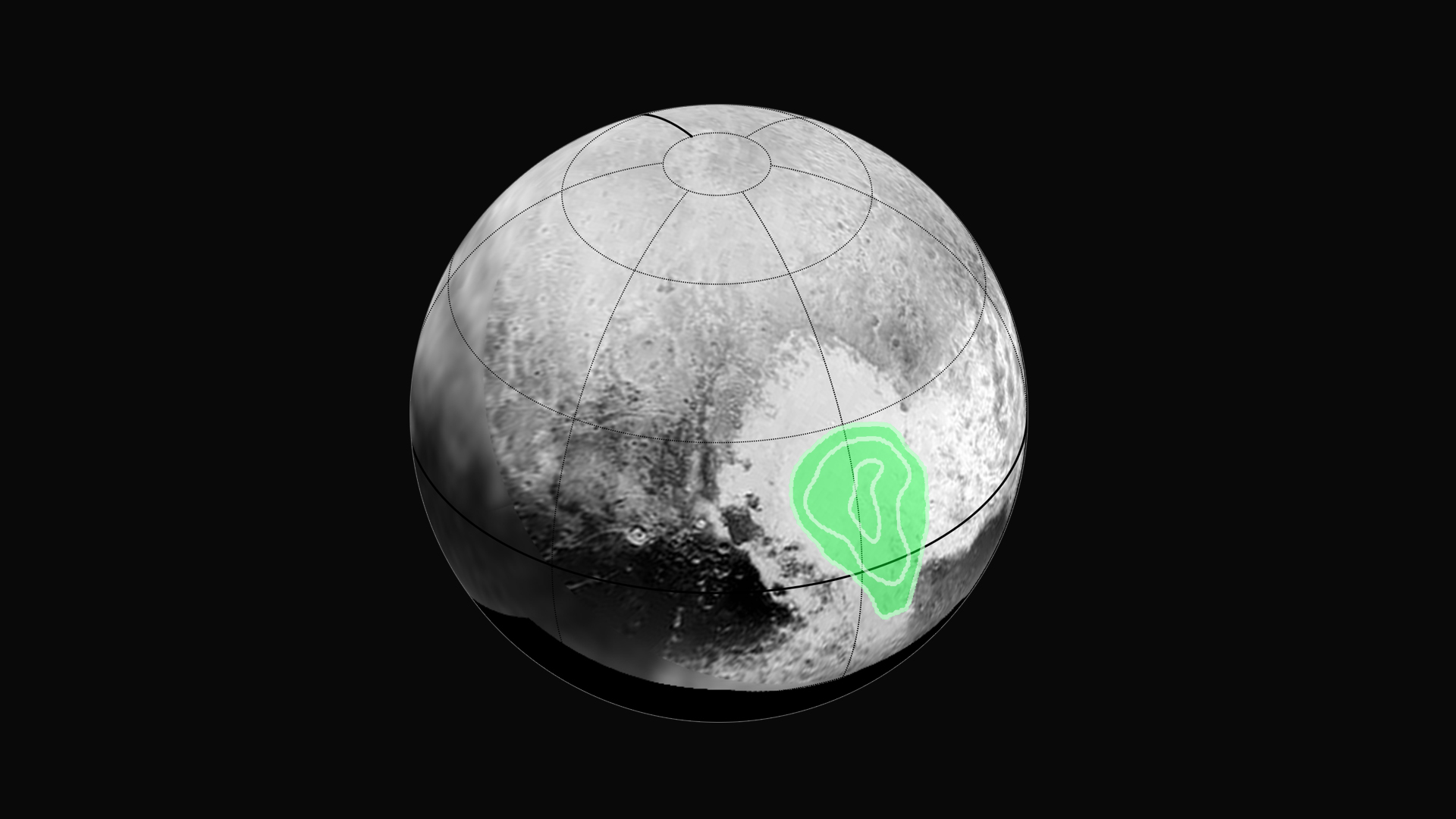
Frozen carbon monoxide in Pluto’s ‘Heart’
Peering closely at the “heart of Pluto,” in the western half of what mission scientists have informally named Tombaugh Regio (Tombaugh Region), New Horizons’ Ralph instrument revealed evidence of carbon monoxide ice. The contours indicate that the concentration of frozen carbon monoxide increases towards the center of the “bull’s eye.” These data were acquired by the spacecraft on July 14 and transmitted to Earth on July 16.
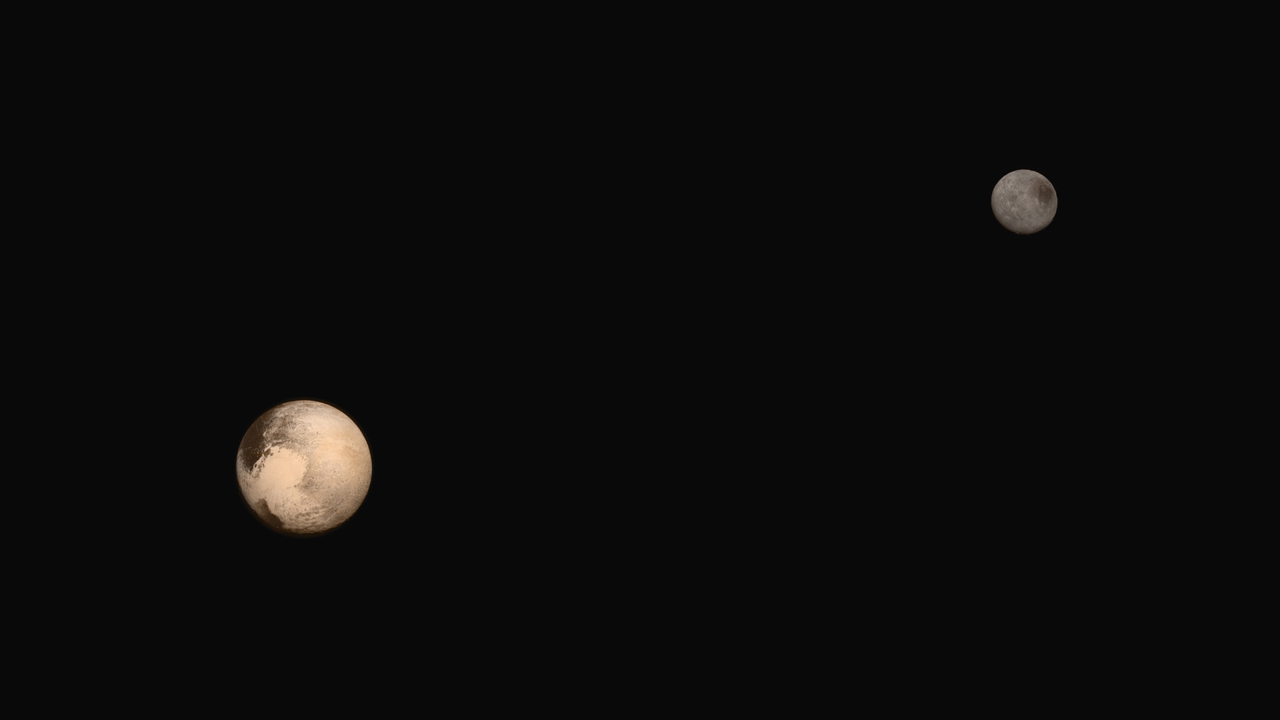
Portrait of Pluto and Charon
The latest two full-frame images of Pluto and Charon were collected separately by New Horizons during approach on July 13 and July 14, 2015. The relative reflectivity, size, separation, and orientations of Pluto and Charon are approximated in this composite image, and they are shown in approximate true color.
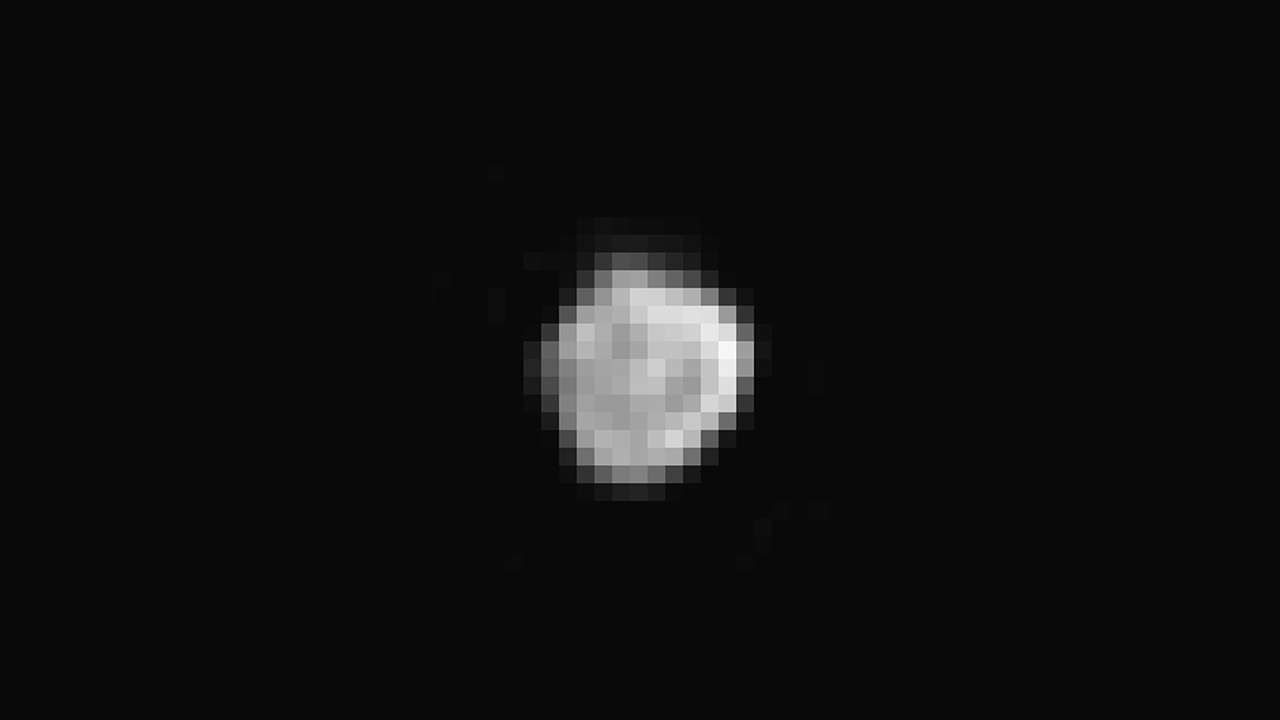
Homing in on Nix, Pluto’s small satellite
Homing in on Pluto’s small satellite Nix, New Horizons’ Long Range Reconnaissance Imager captured this image, which shows features as small as 4 miles (6 kilometers across). Mission scientists believe we are looking at one end of an elongated body about 25 miles (40 kilometers) in diameter. The image was acquired on July 13 from a distance of about 360,000 miles (590,000 kilometers).

Pluto wags its atmospheric ion tail
New Horizons has discovered a region of cold, dense ionized gas tens of thousands of miles beyond Pluto — the planet’s atmosphere being stripped away by the solar wind and lost to space. Beginning an hour and half after closest approach, the Solar Wind Around Pluto (SWAP) instrument observed a cavity in the solar wind — the outflow of electrically charged particles from the Sun — between 48,000 miles (77,000 km) and 68,000 miles (109,000 km) downstream of Pluto. SWAP data revealed this cavity to be populated with nitrogen ions forming a “plasma tail” of undetermined structure and length extending behind the planet.
Similar plasma tails are observed at planets like Venus and Mars. In the case of Pluto’s predominantly nitrogen atmosphere, escaping molecules are ionized by solar ultraviolet light, “picked up” by the solar wind, and carried past Pluto to form the plasma tail discovered by New Horizons. Prior to closest approach, nitrogen ions were detected far upstream of Pluto by the Pluto Energetic Particle Spectrometer Science Investigation (PEPSSI) instrument, providing a foretaste of Pluto’s escaping atmosphere.
Plasma tail formation is but one fundamental aspect of Pluto’s solar wind interaction, the nature of which is determined by several yet poorly constrained factors. Of these, perhaps the most important is the atmospheric loss rate. “This is just a first tantalizing look at Pluto’s plasma environment,” says co-investigator Fran Bagenal, University of Colorado, Boulder, who leads the New Horizons Particles and Plasma team. “We’ll be getting more data in August, which we can combine with the Alice and Rex atmospheric measurements to pin down the rate at which Pluto is losing its atmosphere. Once we know that, we’ll be able to answer outstanding questions about the evolution of Pluto’s atmosphere and surface and determine to what extent Pluto’s solar wind interaction is like that of Mars.”
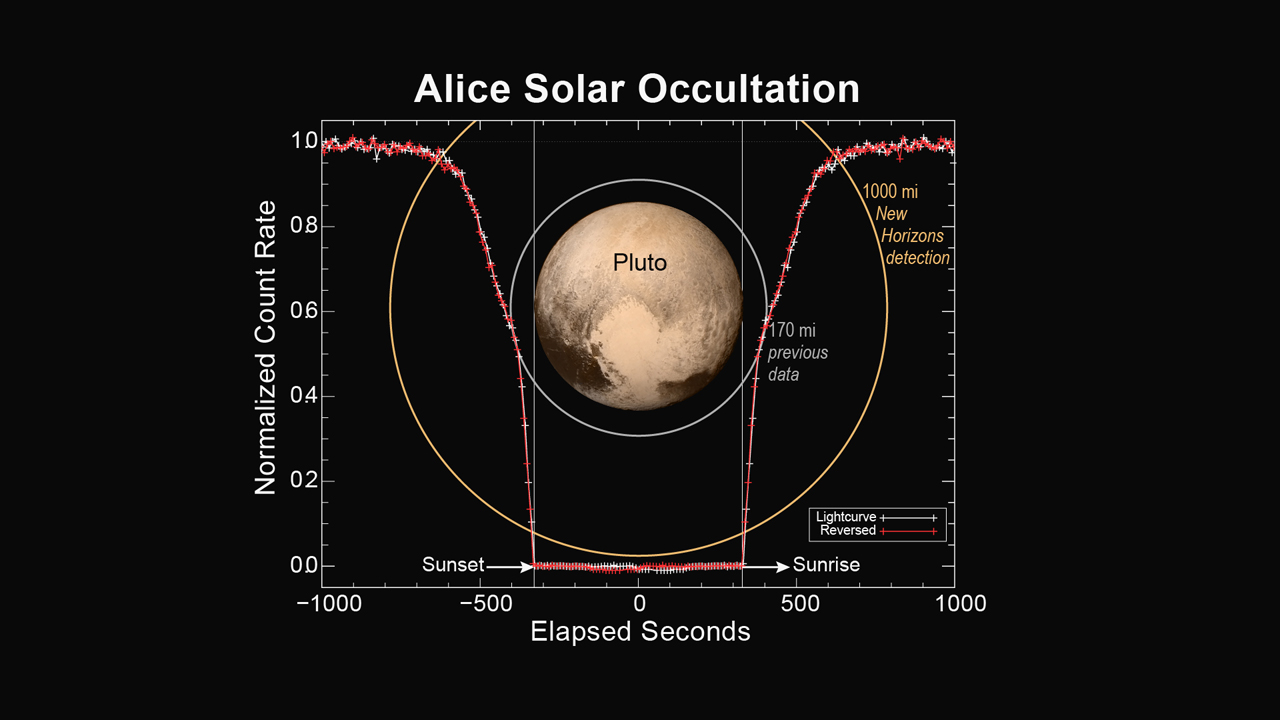
New Horizons reveals Pluto’s extended atmosphere
Scientists working with NASA’s New Horizons spacecraft have observed Pluto’s atmosphere as far as 1,000 miles (1,600 kilometers) above the surface of the planet, demonstrating that Pluto’s nitrogen-rich atmosphere is quite extended. This is the first observation of Pluto’s atmosphere at altitudes higher than 170 miles above the planet’s surface (270 kilometers).
The new information was gathered by New Horizon’s Alice imaging spectrograph during a carefully designed alignment of the sun, Pluto, and the spacecraft starting about an hour after the craft’s closest approach to the planet on July 14. During the event known as a solar occultation, New Horizons passed through Pluto’s shadow while the sun backlit Pluto’s atmosphere.
“This is only the beginning for Pluto atmospheric science” says New Horizons scientist Andrew Steffl of the Southwest Research Institute in Boulder, Colorado. “Next month, the full Alice occultation dataset will be sent to Earth for analysis. Even so, the data we have now show that Pluto’s atmosphere rises higher above its surface, in relative terms, than does the Earth’s.”
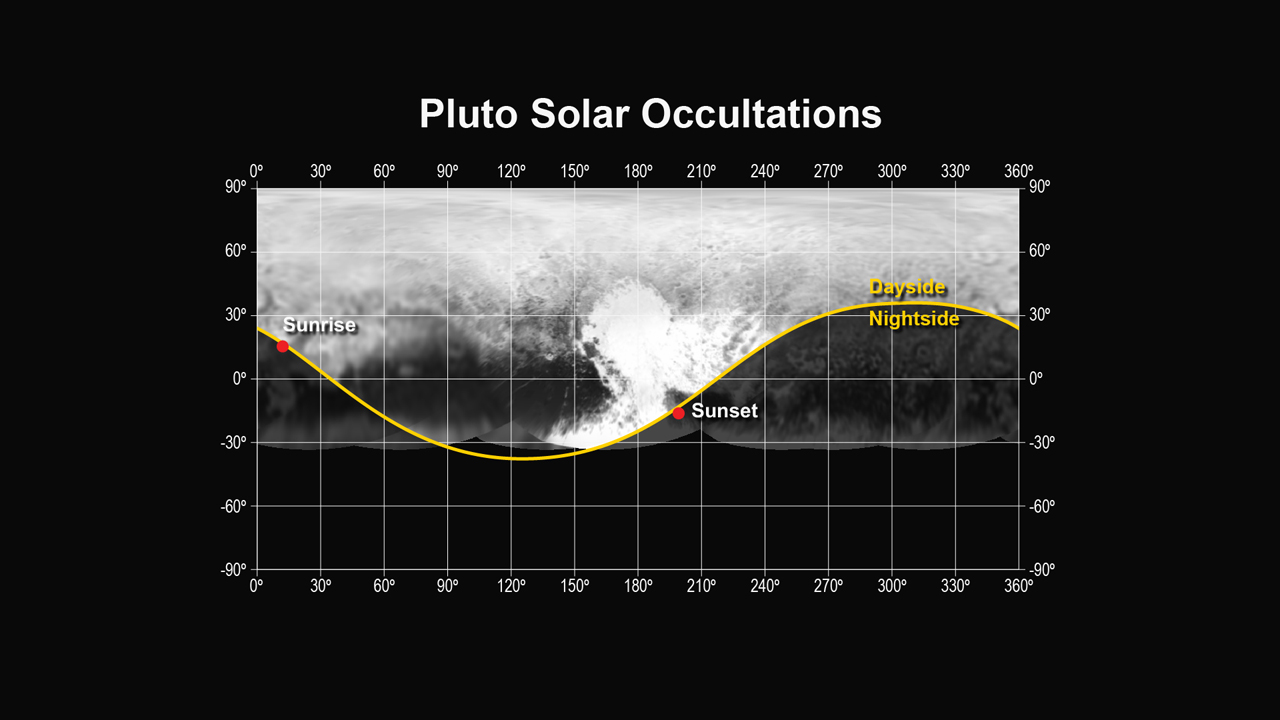
Alice Occultation – Gladstone
This animation shows how the count rate observed by New Horizons’ Alice instrument decreases as Pluto’s atmosphere passes in front of the sun. The decreasing count rate is due to the ultraviolet sunlight having to pass through progressively larger amounts of the atmosphere as the spacecraft line of sight gets closer to Pluto. The observed count rates are compared with predictions based on two plausible models of Pluto’s atmosphere: a “turbulent” case, where the expected count rate is relatively large, due to small amounts of sunlight-absorbing hydrocarbons in the lower atmosphere, and a “stagnant” case, where much larger hydrocarbon abundances are predicted. The preliminary count rate data from Alice are matched by neither model, but are closer to the stagnant case.
July 16, 2015 update:
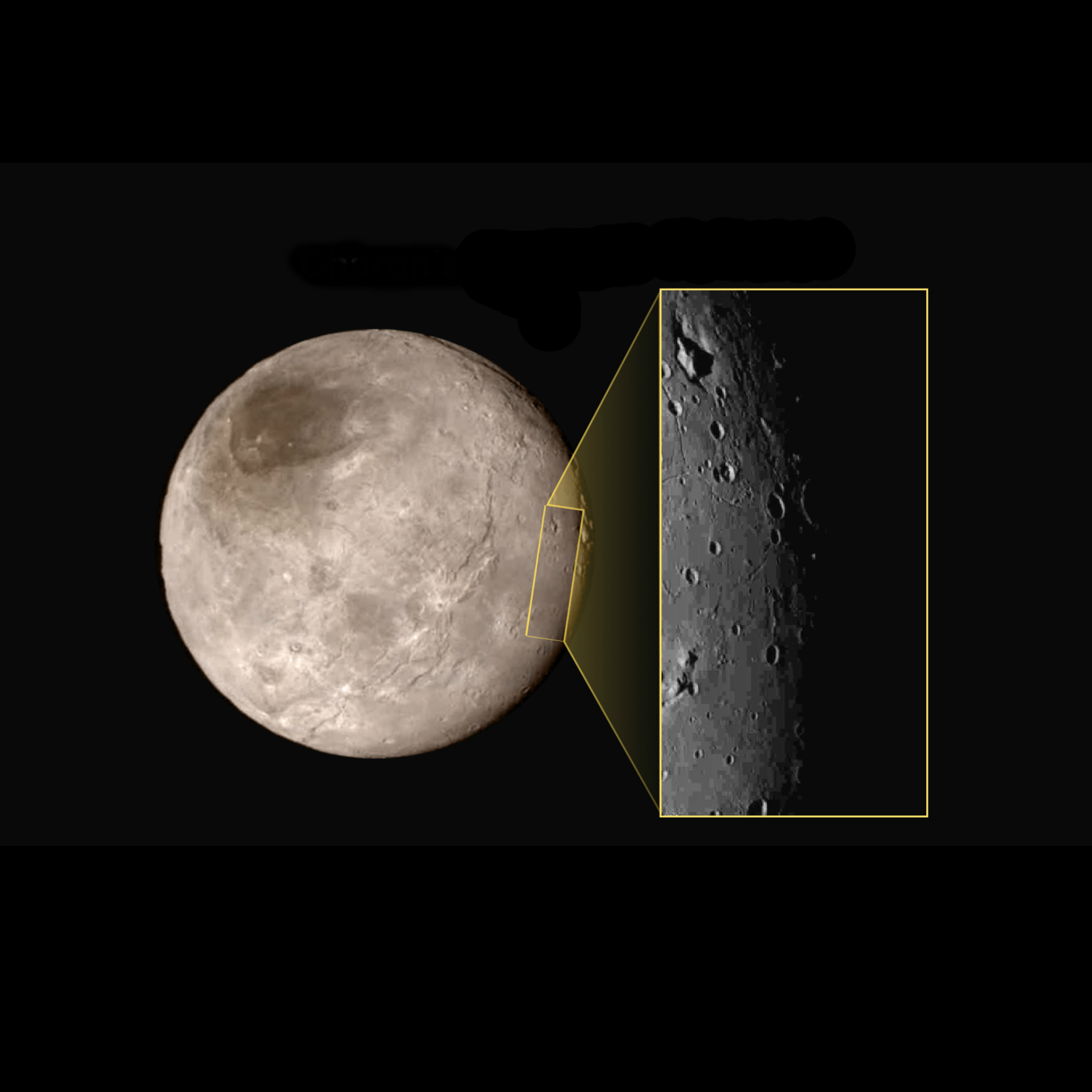
Close-up of Charon’s ‘Mountain in a Moat’
This new image of an area on Pluto’s largest moon Charon has a captivating feature—a depression with a peak in the middle, shown here in the upper left corner of the inset.
The image shows an area approximately 240 miles (390 kilometers) from top to bottom, including few visible craters. “The most intriguing feature is a large mountain sitting in a moat,” said Jeff Moore with NASA’s Ames Research Center, Moffett Field, California, who leads New Horizons’ Geology, Geophysics and Imaging team. “This is a feature that has geologists stunned and stumped.”
This image gives a preview of what the surface of this large moon will look like in future close-ups from NASA’s New Horizons spacecraft. This image is heavily compressed; sharper versions are anticipated when the full-fidelity data from New Horizons’ Long Range Reconnaissance Imager (LORRI) are returned to Earth.
The rectangle superimposed on the global view of Charon shows the approximate location of this close-up view.
The image was taken at approximately 6:30 a.m. EDT (10:30 UTC) on July 14, 2015, about 1.5 hours before closest approach to Pluto, from a range of 49,000 miles (79,000 kilometers).
July 15, 2015 updates:

The icy mountains of Pluto
New close-up images of a region near Pluto’s equator reveal a giant surprise: a range of youthful mountains rising as high as 11,000 feet (3,500 meters) above the surface of the icy body.
The mountains likely formed no more than 100 million years ago — mere youngsters relative to the 4.56-billion-year age of the solar system — and may still be in the process of building, says Jeff Moore of New Horizons’ Geology, Geophysics and Imaging Team (GGI). That suggests the close-up region, which covers less than one percent of Pluto’s surface, may still be geologically active today.
Moore and his colleagues base the youthful age estimate on the lack of craters in this scene. Like the rest of Pluto, this region would presumably have been pummeled by space debris for billions of years and would have once been heavily cratered — unless recent activity had given the region a facelift, erasing those pockmarks.
“This is one of the youngest surfaces we’ve ever seen in the solar system,” says Moore.
Unlike the icy moons of giant planets, Pluto cannot be heated by gravitational interactions with a much larger planetary body. Some other process must be generating the mountainous landscape.
“This may cause us to rethink what powers geological activity on many other icy worlds,” says GGI deputy team leader John Spencer of the Southwest Research Institute in Boulder, Colo.
The mountains are probably composed of Pluto’s water-ice “bedrock.”
Although methane and nitrogen ice covers much of the surface of Pluto, these materials are not strong enough to build the mountains. Instead, a stiffer material, most likely water-ice, created the peaks. “At Pluto’s temperatures, water-ice behaves more like rock,” said deputy GGI lead Bill McKinnon of Washington University, St. Louis.
The close-up image was taken about 1.5 hours before New Horizons closest approach to Pluto, when the craft was 478,000 miles (770,000 kilometers) from the surface of the planet. The image easily resolves structures smaller than a mile across.

Pluto: The ice plot thickens
The latest spectra from New Horizons Ralph instrument reveal an abundance of methane ice, but with striking differences from place to place across the frozen surface of Pluto.
“We just learned that in the north polar cap, methane ice is diluted in a thick, transparent slab of nitrogen ice resulting in strong absorption of infrared light,” said New Horizons co-investigator Will Grundy, Lowell Observatory, Flagstaff, Arizona. In one of the visually dark equatorial patches, the methane ice has shallower infrared absorptions indicative of a very different texture. “The spectrum appears as if the ice is less diluted in nitrogen,” Grundy speculated “or that it has a different texture in that area.”
An Earthly example of different textures of a frozen substance: a fluffy bank of clean snow is bright white, but compacted polar ice looks blue. New Horizons’ surface composition team, led by Grundy, has begun the intricate process of analyzing Ralph data to determine the detailed compositions of the distinct regions on Pluto.
This is the first detailed image of Pluto from the Linear Etalon Imaging Spectral Array, part of the Ralph instrument on New Horizons. The observations were made at three wavelengths of infrared light, which are invisible to the human eye. In this picture, blue corresponds to light of wavelengths 1.62 to 1.70 micrometers, a channel covering a medium-strong absorption band of methane ice, green (1.97 to 2.05 micrometers) represents a channel where methane ice does not absorb light, and red (2.30 to 2.33 micrometers) is a channel where the light is very heavily absorbed by methane ice. The two areas outlined on Pluto show where Ralph observations obtained the spectral traces at the right. Note that the methane absorptions (notable dips) in the spectrum from the northern region are much deeper than the dips in the spectrum from the dark patch. The Ralph data were obtained by New Horizons on July 12, 2015.
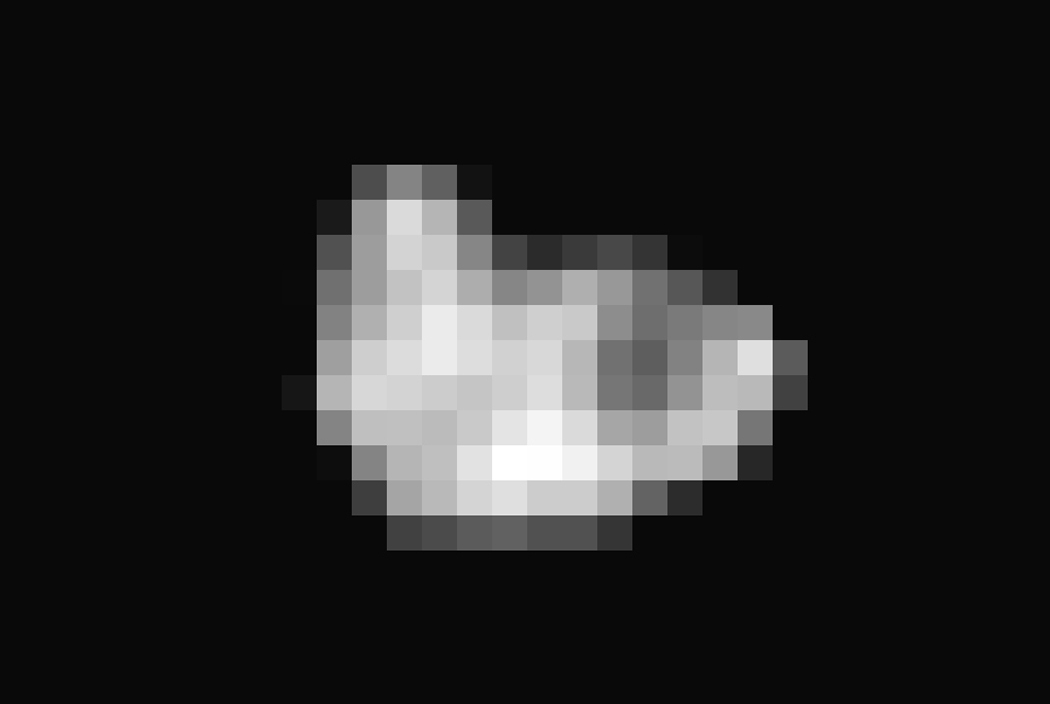
Hydra emerges from the shadows
Since its discovery in 2005, Pluto’s moon Hydra has been known only as a fuzzy dot of uncertain shape, size, and reflectivity. Imaging obtained during New Horizons’ historic transit of the Pluto-Charon system and transmitted to Earth early this morning has definitively resolved these fundamental properties of Pluto’s outermost moon. Long Range Reconnaissance Imager (LORRI) observations revealed an irregularly shaped body characterized by significant brightness variations over the surface. With a resolution of 2 miles (3 kilometers) per pixel, the LORRI image shows the tiny potato-shaped moon measures 27 miles (43 kilometers) by 20 miles (33 kilometers).
Like that of Charon, Hydra’s surface is probably covered with water ice, the most abundant ice in the universe. Observed within Hydra’s bright regions is a darker circular structure with a diameter of approximately 6 miles (10 kilometers). Hydra’s reflectivity (the percentage of incident light reflected from the surface) is intermediate between that of Pluto and Charon. “New Horizons has finally nailed the basic physical properties of Hydra,” says Hal Weaver, New Horizons Project Scientist and LORRI science operations lead. “We’re going to see Hydra even better in the images yet to come.”
Hydra was approximately 400,000 miles away from New Horizons when the image was acquired.
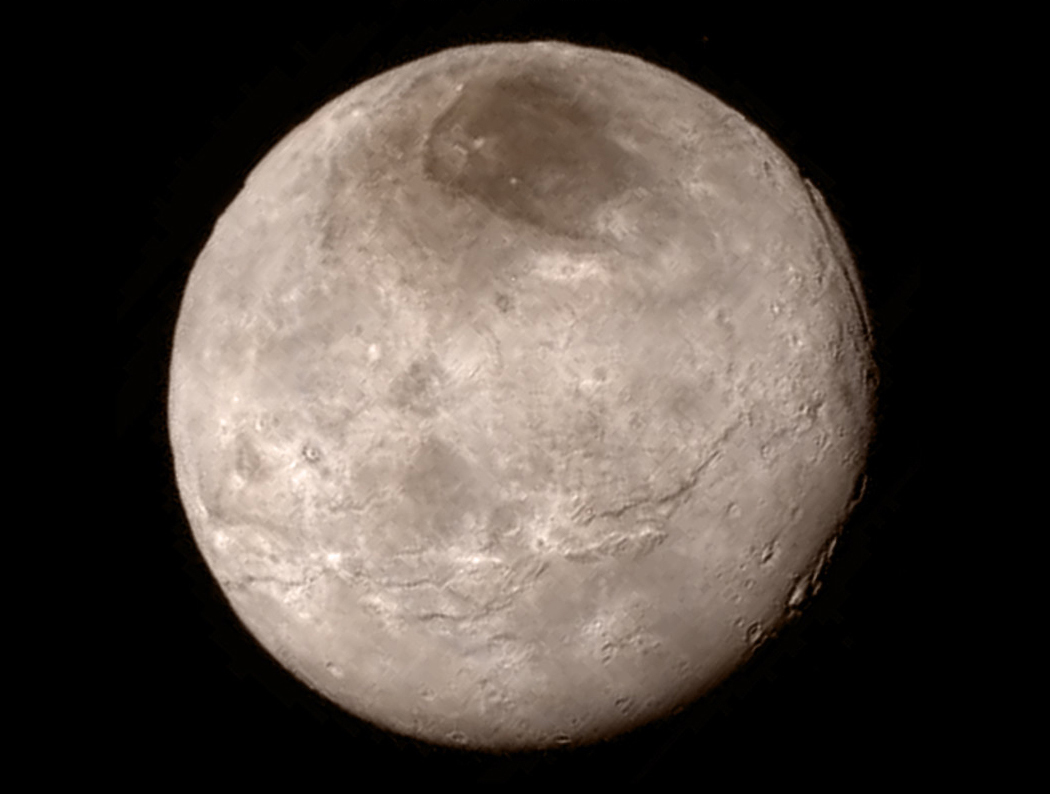
Charon’s surprising youthful and varied terrain
Remarkable new details of Pluto’s largest moon Charon are revealed in this image from New Horizons’ Long Range Reconnaissance Imager (LORRI), taken late on July 13, 2015 from a distance of 289,000 miles (466,000 kilometers).
A swath of cliffs and troughs stretches about 600 miles (1,000 kilometers) from left to right, suggesting widespread fracturing of Charon’s crust, likely a result of internal processes. At upper right, along the moon’s curving edge, is a canyon estimated to be 4 to 6 miles (7 to 9 kilometers) deep.
Mission scientists are surprised by the apparent lack of craters on Charon. South of the moon’s equator, at the bottom of this image, terrain is lit by the slanting rays of the sun, creating shadows that make it easier to distinguish topography. Even here, however, relatively few craters are visible, indicating a relatively young surface that has been reshaped by geologic activity.
In Charon’s north polar region, a dark marking prominent in New Horizons’ approach images is now seen to have a diffuse boundary, suggesting it is a thin deposit of dark material. Underlying it is a distinct, sharply bounded, angular feature; higher resolution images still to come are expected to shed more light on this enigmatic region.
The image has been compressed to reduce its file size for transmission to Earth. In high-contrast areas of the image, features as small as 3 miles (5 kilometers) across can be seen. Some lower-contrast detail is obscured by the compression of the image, which may make some areas appear smoother than they really are. The uncompressed version still resides in New Horizons’ computer memory and is scheduled to be transmitted at a later date.
The image has been combined with color information obtained by New Horizons’ Ralph instrument on July 13.
New Horizons traveled more than three billion miles over nine-and-a-half years to reach the Pluto system.
July 14, 2015 update:
Celebrating the Pluto flyby

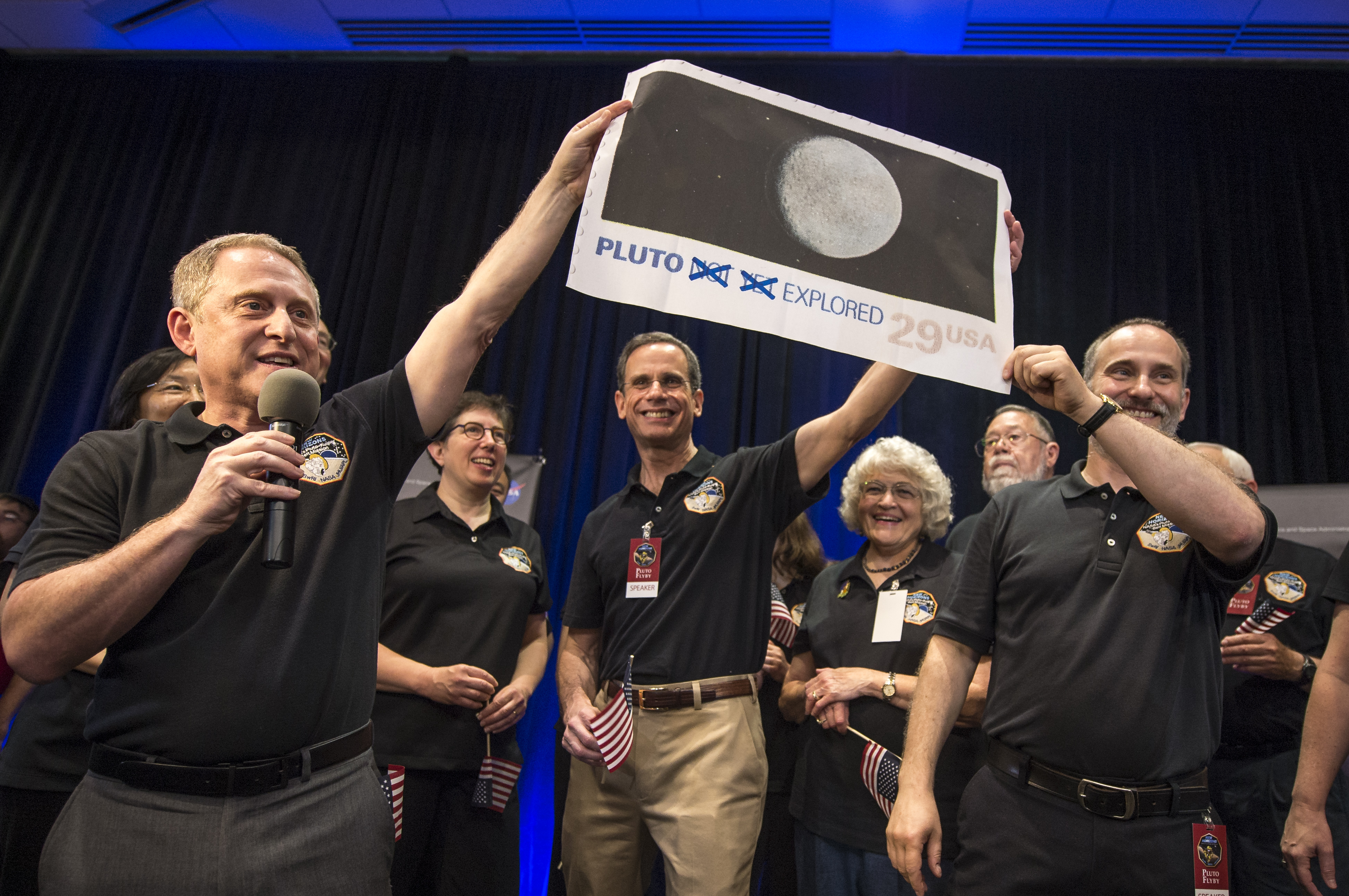

July 13, 2015 updates:
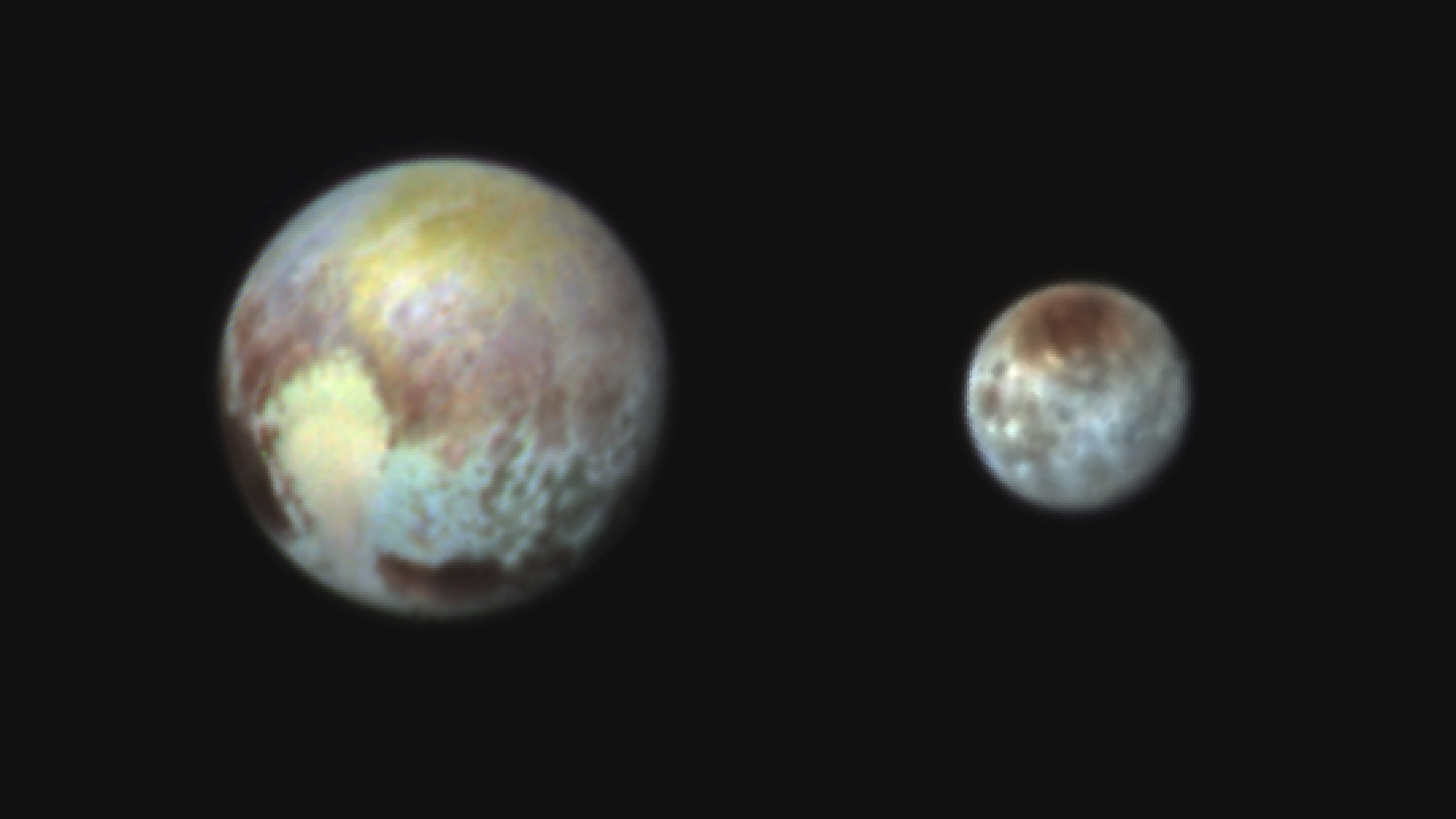
Pluto and Charon in false color show compositional diversity
This July 13, 2015, image of Pluto and Charon is presented in false colors to make differences in surface material and features easy to see. It was obtained by the Ralph instrument on NASA’s New Horizons spacecraft, using three filters to obtain color information, which is exaggerated in the image. These are not the actual colors of Pluto and Charon, and the apparent distance between the two bodies has been reduced for this side-by-side view.
The image reveals that the bright heart-shaped region of Pluto includes areas that differ in color characteristics. The western lobe, shaped like an ice-cream cone, appears peach color in this image. A mottled area on the right (east) appears bluish. Even within Pluto’s northern polar cap, in the upper part of the image, various shades of yellow-orange indicate subtle compositional differences.
The surface of Charon is viewed using the same exaggerated color. The red on the dark northern polar cap of Charon is attributed to hydrocarbon materials including a class of chemical compounds called tholins. The mottled colors at lower latitudes point to the diversity of terrains on Charon.
This image was captured at 3:38 a.m. EDT on July 13, one day before New Horizon’s closest approach to Pluto.
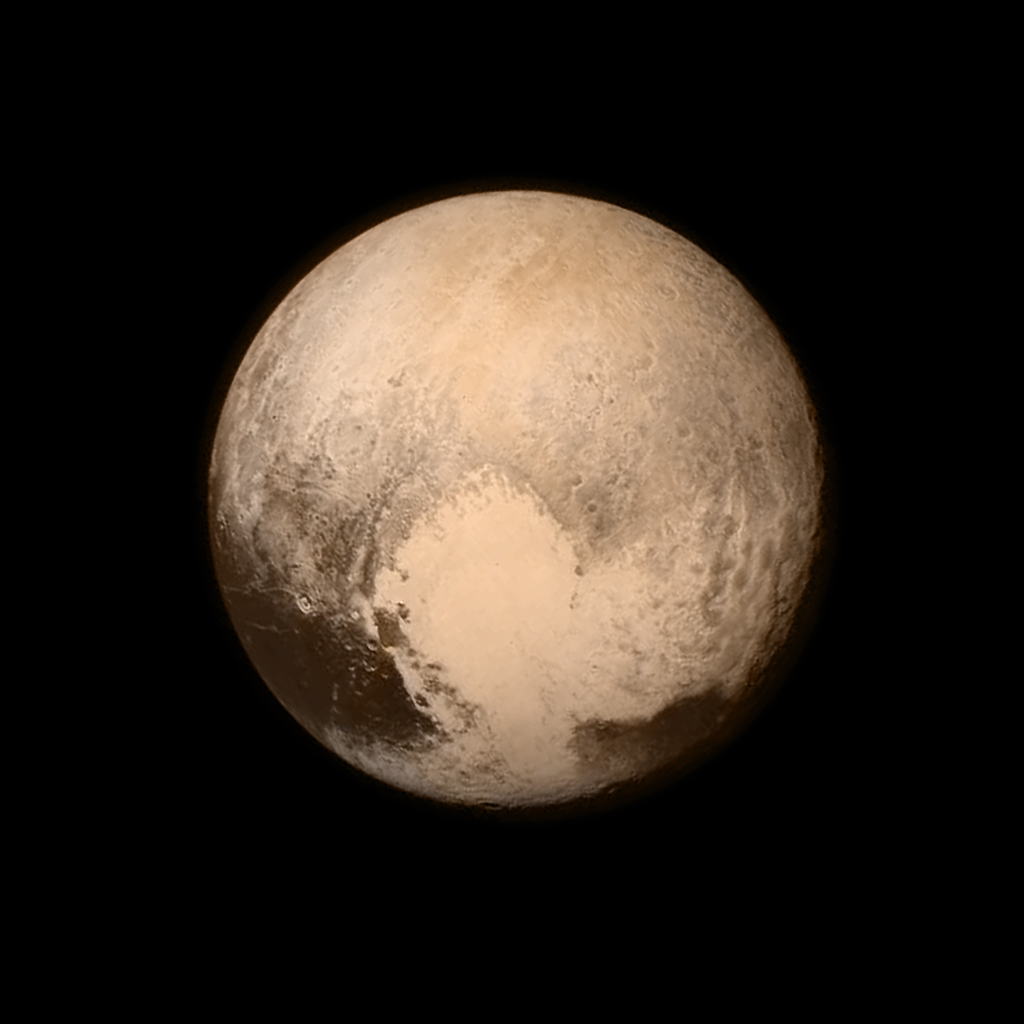
Approaching Pluto
Pluto nearly fills the frame in this image from the Long Range Reconnaissance Imager (LORRI) aboard NASA’s New Horizons spacecraft, taken on July 13, 2015, when the spacecraft was 476,000 miles (768,000 kilometers) from the surface. This is the last and most detailed image sent to Earth before the spacecraft’s closest approach to Pluto on July 14. The color image has been combined with lower-resolution color information from the Ralph instrument that was acquired earlier on July 13.
This view is dominated by the large, bright feature informally named the “heart,” which measures approximately 1,000 miles (1,600 kilometers) across. The heart borders darker equatorial terrains, and the mottled terrain to its east (right) are complex. However, even at this resolution, much of the heart’s interior appears remarkably featureless-possibly a sign of ongoing geologic processes.
July 11, 2015 update:
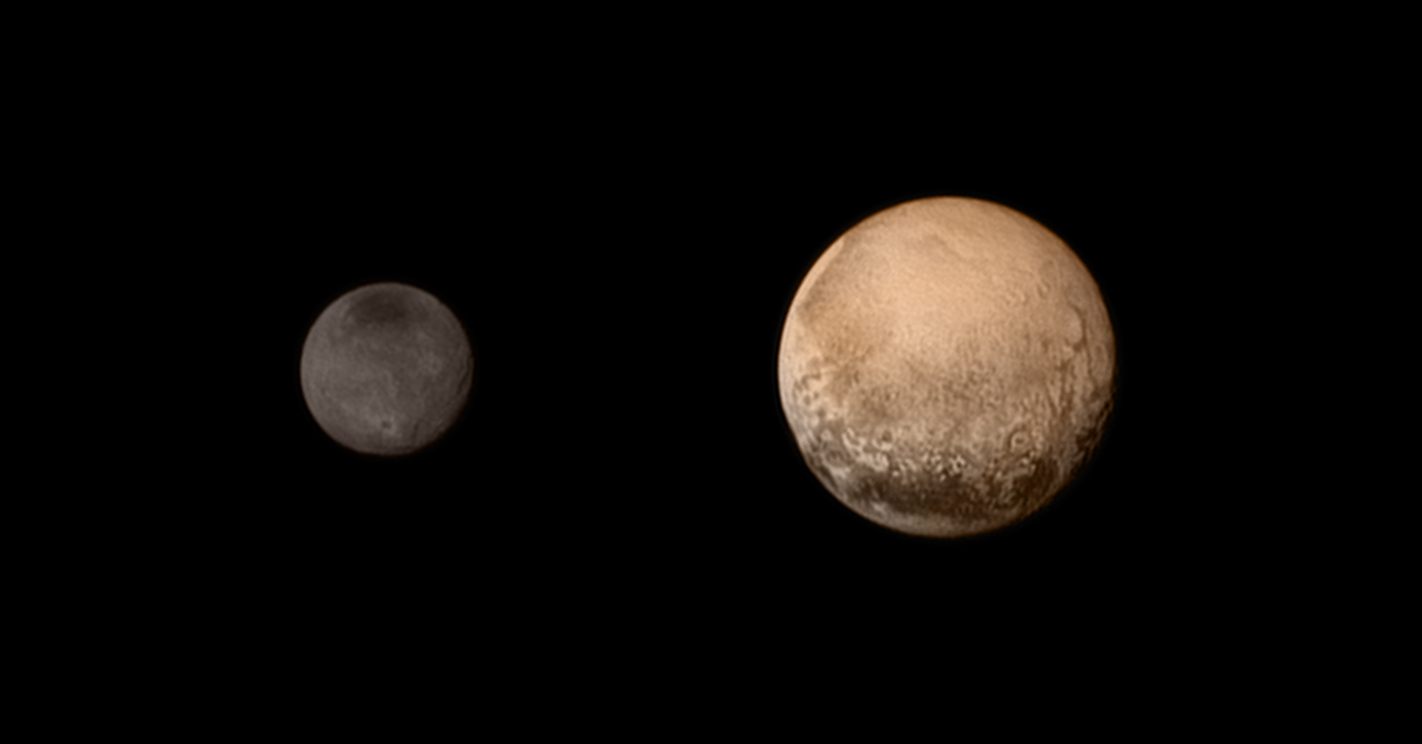
Final approach: Pluto and Charon
A portrait from the final approach. Pluto and Charon display striking color and brightness contrast in this composite image from 11 July 2015, showing high-resolution black-and-white LORRI images colorized with Ralph data collected from the last rotation of Pluto. Color data being returned by the spacecraft now will update these images, bringing color contrast into sharper focus.
July 8, 2015 updates:
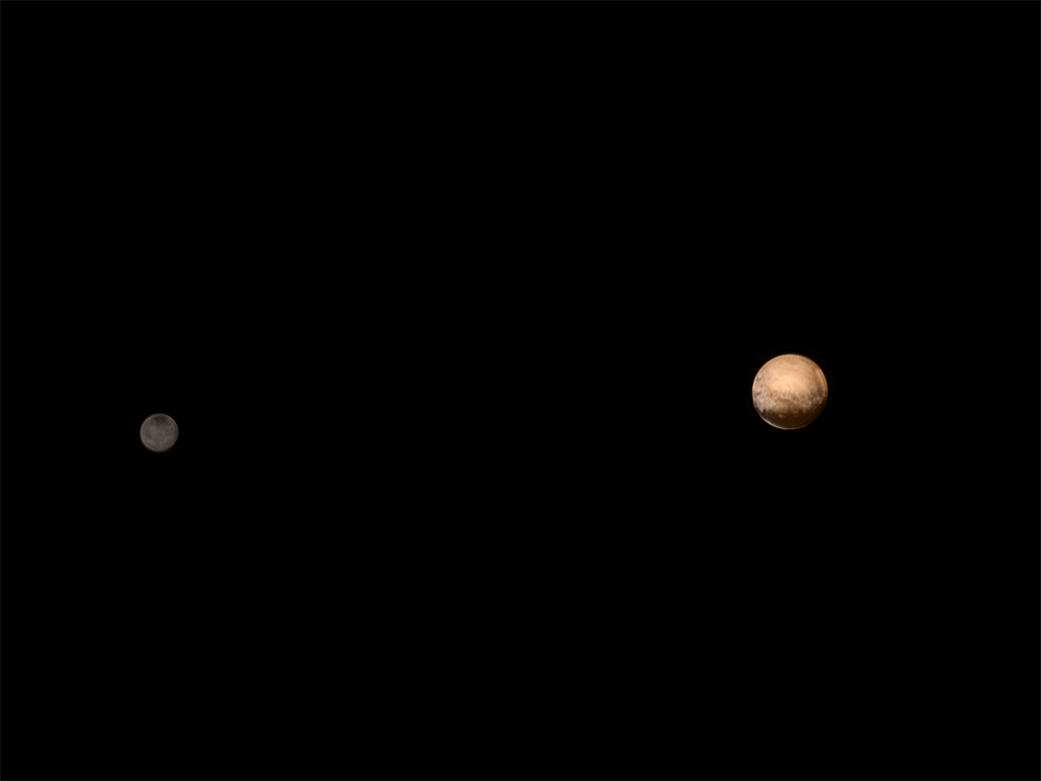
Pluto and Charon: New Horizons’ dynamic duo
They’re a fascinating pair: Two icy worlds, spinning around their common center of gravity like a pair of figure skaters clasping hands. Scientists believe they were shaped by a cosmic collision billions of years ago, and yet, in many ways, they seem more like strangers than siblings.
New Horizons was about 3.7 million miles (6 million kilometers) from Pluto and Charon when it snapped this portrait late on 8 July 8 2015.
A high-contrast array of bright and dark features covers Pluto’s surface, while on Charon, only a dark polar region interrupts a generally more uniform light gray terrain. The reddish materials that color Pluto are absent on Charon. Pluto has a significant atmosphere; Charon does not. On Pluto, exotic ices like frozen nitrogen, methane, and carbon monoxide have been found, while Charon’s surface is made of frozen water and ammonia compounds. The interior of Pluto is mostly rock, while Charon contains equal measures of rock and water ice.
“These two objects have been together for billions of years, in the same orbit, but they are totally different,” said Principal Investigator Alan Stern of the Southwest Research Institute (SwRI), Boulder, Colorado.
Charon is about 750 miles (1200 kilometers) across, about half the diameter of Pluto-making it the solar system’s largest moon relative to its planet. Its smaller size and lower surface contrast have made it harder for New Horizons to capture its surface features from afar, but the latest, closer images of Charon’s surface show intriguing fine details.
Newly revealed are brighter areas on Charon that members of the mission’s Geology, Geophysics and Imaging team (GGI) suspect might be impact craters. If so, the scientists would put them to good use. “If we see impact craters on Charon, it will help us see what’s hidden beneath the surface,” said GGI leader Jeff Moore of NASA’s Ames Research Center. “Large craters can excavate material from several miles down and reveal the composition of the interior.”
In short, said GGI deputy team leader John Spencer of SwRI, “Charon is now emerging as its own world. Its personality is beginning to really reveal itself.”
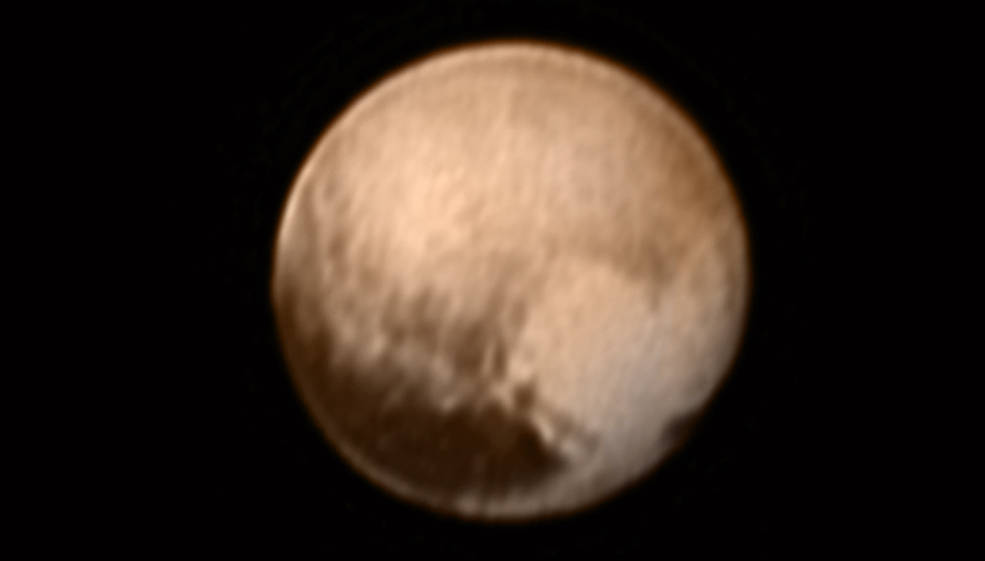
A heart from Pluto
After a more than nine-year, three-billion-mile journey to Pluto, it’s show time for NASA’s New Horizons spacecraft, as the flyby sequence of science observations is officially underway.
In the early morning hours of July 8, mission scientists received this new view of Pluto-the most detailed yet returned by the Long Range Reconnaissance Imager (LORRI) aboard New Horizons. The image was taken on July 7, when the spacecraft was just under 5 million miles (8 million kilometers) from Pluto, and is the first to be received since the July 4 anomaly that sent the spacecraft into safe mode.
This view is centered roughly on the area that will be seen close-up during New Horizons’ July 14 closest approach. This side of Pluto is dominated by three broad regions of varying brightness. Most prominent are an elongated dark feature at the equator, informally known as “the whale,” and a large heart-shaped bright area measuring some 1,200 miles (2,000 kilometers) across on the right. Above those features is a polar region that is intermediate in brightness.
“The next time we see this part of Pluto at closest approach, a portion of this region will be imaged at about 500 times better resolution than we see today,” said Jeff Moore, Geology, Geophysics and Imaging Team Leader of NASA’s Ames Research Center. “It will be incredible!”
July 3, 2015 update:
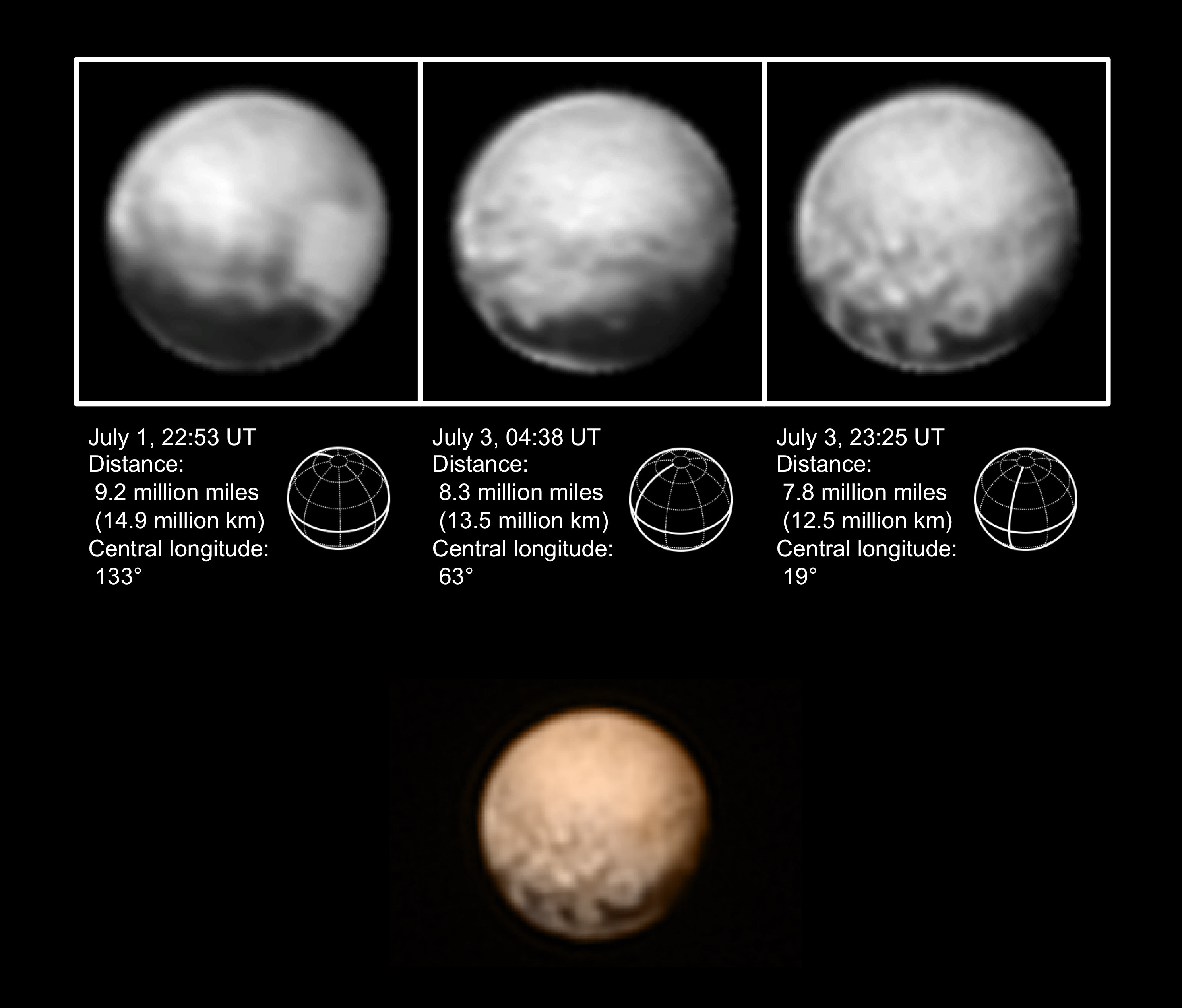
Mysterious dark spots on Pluto
These are the most recent high-resolution views of Pluto sent by NASA’s New Horizons spacecraft, including one showing the four mysterious dark spots on Pluto that have captured the imagination of the world. The Long Range Reconnaissance Imager (LORRI) obtained these three images between July 1 and 3 of 2015, prior to the July 4 anomaly that sent New Horizons into safe mode.
The left image shows, on the right side of the disk, a large bright area on the hemisphere of Pluto that will be seen in close-up by New Horizons on July 14. The three images together show the full extent of a continuous swath of dark terrain that wraps around much of Pluto’s equatorial region. The western end of the swath (right image) breaks up into a series of striking dark regularly-spaced spots, each hundreds of miles in size, which were first detected in New Horizons images taken in late June. Intriguing details are beginning to emerge in the bright material north of the dark region, in particular a series of bright and dark patches that are conspicuous just below the center of the disk in the right image. In all three black-and-white views, the apparent jagged bottom edge of Pluto is the result of image processing. The inset shows Pluto’s orientation, illustrating its north pole, equator, and central meridian running from pole to pole.
The color version of the July 3 LORRI image was created by adding color data from the Ralph instrument gathered earlier in the mission.

